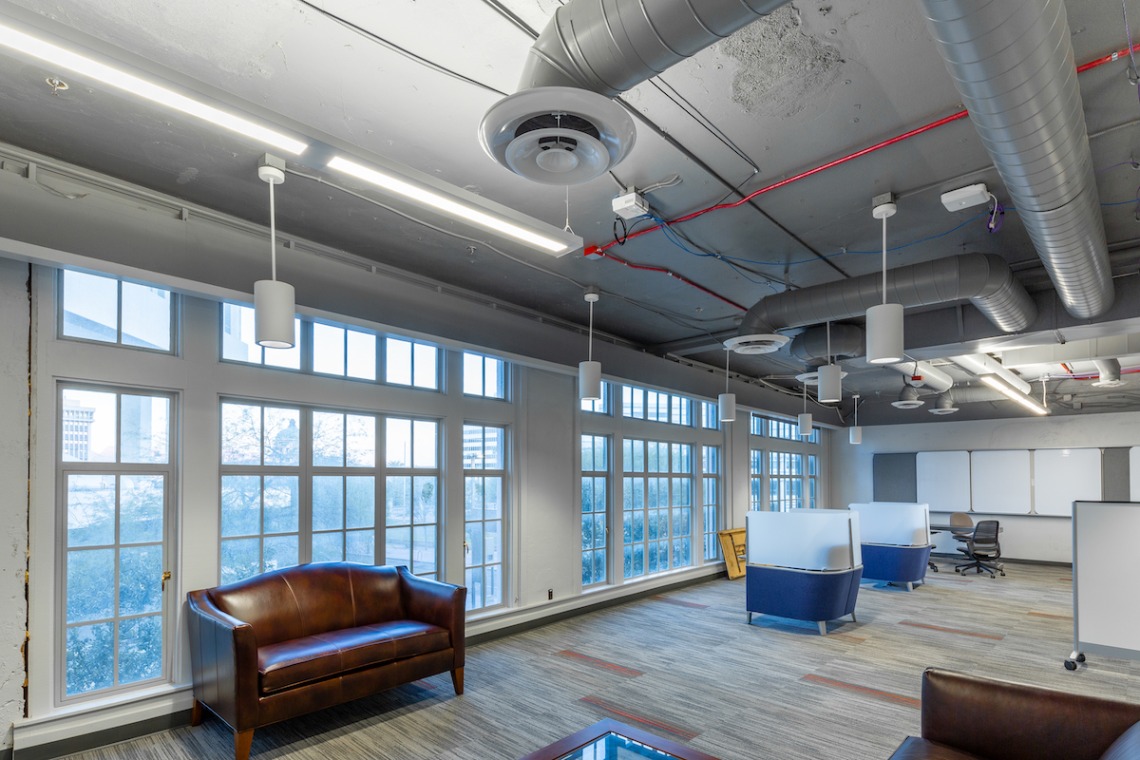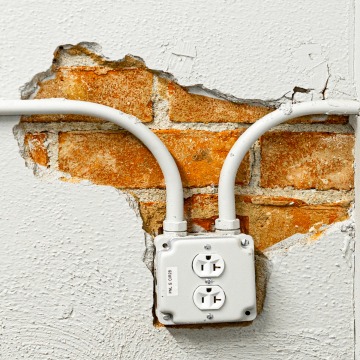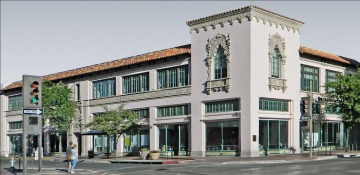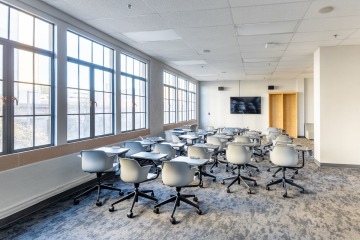Arizona FORGE at Roy Place: An entrepreneurial training ground for students and an innovative environment for faculty, staff and the community

FORGE at Roy Place offers spaces for groups of all sizes, including this second-story multiple-use room.

Areas inside the Roy Place Building were purposely left unfinished to emphasize the importance of moving forward with ideas rather than being paralyzed by perfection.

A street view of the Roy Place Building, home to Arizona FORGE.

Instructors are invited to use the Rincon Classroom, which has three screens and seating for 35.
Arizona FORGE is ready to share its downtown space and campus locations with faculty, students and the community.
Arizona FORGE – short for Finding Opportunities and Resources to Grow Entrepreneurs – is a unit of Research, Innovation & Impact designed to bring students, faulty, staff, community and industry together to learn from each other and develop problem solving, critical thinking and resiliency skills to support a vibrant innovation ecosystem.
"Given that faculty are by definition involved with students, and probably many are invested in the community, I'd like them to know that they are welcome to contribute to our mission," said founding director Brian Ellerman. A longtime member of the Tucson startup community, Ellerman has more than 25 years of experience in health technology. He has traveled the globe connecting incubators, accelerators, startups and venture capital firms to address complex business challenges.
March 26, 2020, was slated to be the day that FORGE opened its flagship downtown location in the Roy Place Building, at the southeast corner of East Pennington Street and North Stone Avenue. The pandemic forced a cancellation of the grand opening but it didn't stop the activities inside.
FORGE at Roy Place
When you approach FORGE at Roy Place for the first time, you might notice the Spanish colonial revival style of the building. Designed and built by architect Roy Place nearly a century ago, it is similar to his other buildings around town, including Centennial Hall and Mansfeld Middle Magnet School.
Before FORGE moved in, the building was home to a Montgomery Ward department store and even a Walgreens. Renovations are now complete, but evidence of the building's history remains. So-called blemishes – areas that were purposely left unfinished – can be found throughout the 24,000-square-foot space. Those features symbolize an entrepreneurial mindset and serve as a subtle reminder that the people who use FORGE spaces need to let go of the idea of perfection and instead just get started.
The space is designed to provide education, community, common space, services and mentors. There are three spaces available to campus:
Rincon Classroom – Visiting classes and organizations are invited to use the Rincon Classroom, located on the second floor, which is a flexible learning space with three screens and 25 moving desks as well as couches that allow the room to accommodate up to 35 people comfortably. Arizona FORGE is always looking for faculty partners and can help find guest speakers on any topic related to innovation and entrepreneurship, Ellerman says.
War Room – This space is used by teams that are working – sometimes loudly – to solve a problem. In order to use the space, teams must post a description of the problem outside the room. Once resolved, the team must give a presentation to others who use Arizona FORGE.
Pennington Room – With a boardroom-like setting, this space can fit about 18 people. There is a 65-inch television display, an Owl all-in-one 360-degree camera, microphone and speaker. There are also track-mounted modular whiteboards for brainstorming and a beautiful view of the Santa Catalina Mountains.
"In March 2020, our efforts were focused on the building downtown," Ellerman said. "We wanted to have that base of operations there and then start thinking about what else."
Ellerman worked with Jim Buizer, interim director of the Arizona Institute for Resilient Environments and Societies, and others who works at the institute, to open the most recent campus location: the Resilience FORGE in Environment and Natural Resources 2. Every two weeks, a representative of the West Coast U.S. Patent and Trademark Office is available virtually to answer questions, while FORGE holds occasional lunch-and-learn sessions at ENR2 (the next lunch-and-learn is April 27 at 1 p.m.) FORGE also holds office hours three days a week.
"If a faculty member wanted to stop by the Resilience FORGE, we would welcome them as we would a student," he said. "From our point of view, our ultimate goal is cultivating an entrepreneurial mindset. It's not limited to any one group or college."
Entrepreneurial training ground
Ellerman and his team at Arizona FORGE are developing collaborations across campus and across the state to make FORGE's services more widely available.
By fall, David Hahn, the Craig M. Berge Dean of the College of Engineering, and Ellerman will open the STEAM – science, technology, engineering, art and medicine) FORGE in the Electrical and Computer Engineering building. Ellerman is hoping to hold office hours in the Health Sciences Innovation Building for health and biomedical entrepreneurship.
Ellerman is also working to establish a presence for FORGE at the Phoenix Biomedical Campus and the Yuma Center of Excellence for Desert Agriculture. He's also working with Nathan Levi Esquerra, senior vice president for Native American Advancement and Tribal Engagement, on offering FORGE's mini-courses and mentoring to Native nations.
Ellerman and team also are working to expand their presence in the Pima County Joint Technical Education District program for high school students.
One of the areas of focus for FORGE in recent years is Student Venture Pathways, which aims to expose students to entrepreneurial concepts and inspire an entrepreneurial mindset. Among the activities offered through the initiative are sponsored innovation challenges, student networking events, internships, venture‐based mini‐courses, and pitch and business plan competitions.
Through Student Venture Pathways – which has received support from the Technology and Research Initiative Fund – Ellerman hopes to offer FORGE's programming as an add-on to innovation and entrepreneurship courses at the University of Arizona and ultimately develop a FORGE minor.
"For the next 18 months, we'll be heavily focused on building that out," Ellerman said. "We already have great partnerships with a number of colleges, with key assets and allies in each. So, faculty should know that if they're not seeing their college represented here, then reach out. This is a very exciting time for Arizona FORGE."

